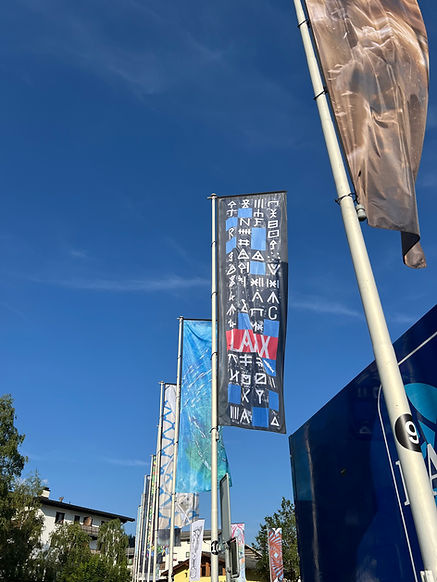
Flag for Ligia Grischa 2024
In the year 1424, twenty-one communities in the valleys of the Vorder- and Hinterrhein in southeast Switzerland came together to form the Grauer Bund (Ligia Grischa), aiming to reinforce safe travel on their roads, free trade and freedom of movement and to ensure the legal rights of ordinary people. Six hundred years later this historic achievement was celebrated in the region in a number of ways. The art centre in Laax, Cularta, invited artists from the region to design commemorative flags to represent one of the original 21 communities. The 21 flags were hung next to the Cularta by the Laaxersee from August 2024 until the end of Spring 2025.
The 21 communities were: Mustér/Disentis, Val Lumnezia, Val/Vals, Glion/Ilanz, Schluein, Versomi/Versam, Vuorz/Waltensburg, Laax, Sursaissa/Obersaxen, Razen/Rhäzuns-Domat/Ems, Trin, Flem/Flims, Val Rein/Rheinwald, Schons/Schams, Tusaun/Thusis, Muntogna/Heinzenberg, Tschappina, Stussavgia/Safien, Misox/Mesocco, Roveredo and Calanca.
I was invited to design a flag for Laax, with the brief: "what Laax means to me". I am a relative newcomer to the village. Like many "foreigners", I first came for the winter sports. Now, more than 20 years later, I have become an official member of the community, with the important right to vote. Over the years I learned the history and geography of the village and region and started to learn Romontsch as well. Having moved house nearly 30 times, in 5 countries on 3 continents it's interesting to live in a village where many people can trace their intertwined family histories over centuries. While researching my own family history, I have to go back three or four hundred years to find many ancestors who stayed in one place for multiple generations. It was this sense of community through the centuries that I wanted to communicate on my flag.
My concept was to use "nodas-casa", or house marks. These are the marks that families used to mark possessions of every kind and to sign documents in centuries gone by before most people were literate. In a farming village such as Laax, tools might be shared, animals pastured together, etc. and everything needed to return to its rightful owner. The designs were easy to carve, scratch or draw, consisting only of a few lines or dots. Similarities can be seen between some of the marks because different generations or branches of the same family would have modified an existing mark. Nodas-casa used in Laax were researched and compiled by local teacher Luzi Coray in 1937 and form part of the official archive of Laax. My reference was the book "Laax Ina vischnaunca grischuna", edited by Alfons Maissen and published in 1978 by Fundaziun Pro Laax.
The nodas-casa are organised by family in alphabetical order from the top left corner, reading left to right across each row. There are 13 family names and a total of 48 nodes-casa. The families are separated by blocks of colour that echo the colours of the landscape.
In order, therefore the marks are:
Arpagaus-Früh Chr.; Arpagaus Joh.-Gg.; Arpagaus Fidel; Arpagaus Peter;
Arpagaus Eusebius; ----; Blumenthal Jak. Gg.; Blumenthal Heinrich;
----; Camathias Nik. Ant.; Camathias Balzer; Camathias Othmar;
Camathias Joh. Christ.; Camathias-Solèr J. Fl.;----; Cagianuth Agnes;
----; Casutt Joh. Math.;----; Cavelti Victor; Cavelti Jodocus;
Cavelti Jodocus; Cavelti Juli; Cavelti Josef; Cavelti Leonhard; Cavelti Luzius;
Cavelti Luzius; Cavelti Gaudenz, Hptm.;----;Coray Jak. Gaudenz;
Coray Veronica; Coray Barla Rosa; Coray Chr. Flurin; Coray Joh. Flurin;
Coray Vinzens; Coray Franz; Coray Moritz; Coray Caspar;
Coray-Bearth Flurin; Coray Peter, Lt.;Coray Fidel; Coray-Camathias J. Ulr.;
Coray Bartholome;----; de Mont Ursulina;----;
Derungs Peter Ant.; Derungs Martin Ant.; Derungs Joh. Martin;----;
Gliott Joh. Ant.;Gliott Felix; Gliott Johanna; Gliott Math. Ant.;
----; Sievi Gg.Ant.; Sievi Nic. Josef;----;
Solèr Thomas; Solèr Valentin;----; Toggenburg, Major;

